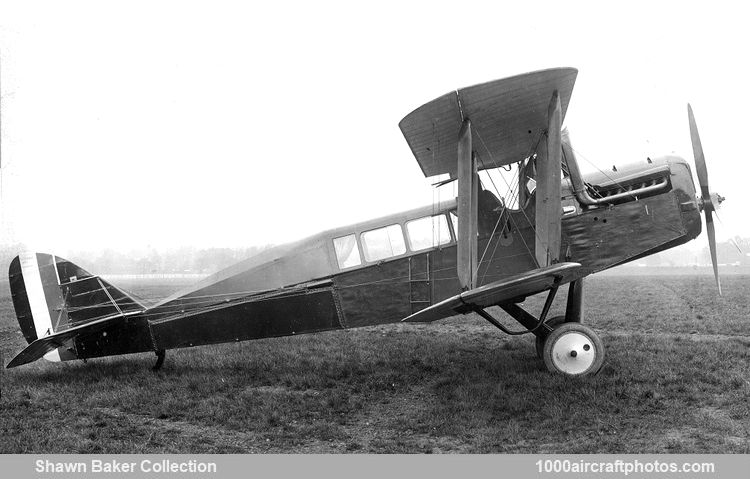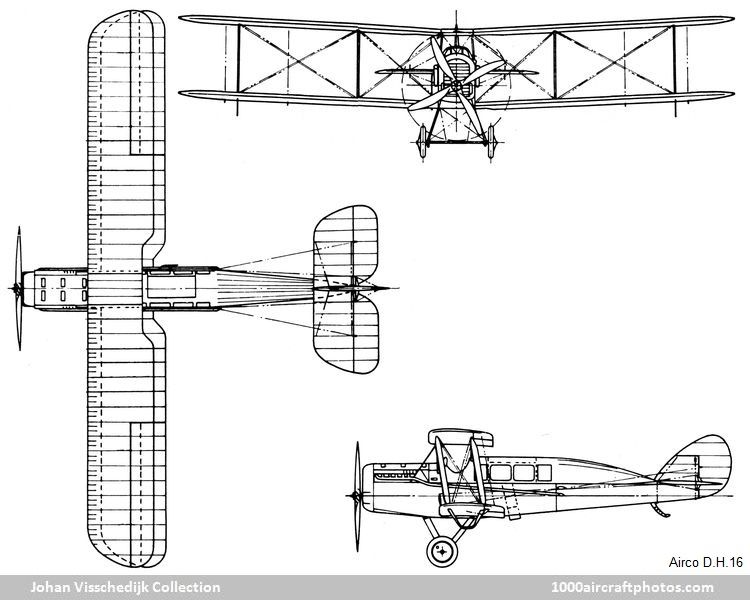The D.H.16, Airco's first purely civilian type, was consequently built from D.H.9A instead of D.H.4 components and the rear fuselage was widened to seat four passengers in facing pairs in a glazed cabin. Although powered by the 320 hp Rolls-Royce Eagle VIII twelve-cylinder liquid-cooled V-engine of its predecessor, it was faster and carried four instead of two fare paying passengers, making it a considerably more economical and commercially attractive aircraft.
The above pictured prototype first flew at Hendon in March 1919 in contemporary khaki drab with red, white and blue rudder. In the following May it entered service with Aircraft Transport and Travel Ltd. (AT & T) bearing the temporary civil marking K-130. With 'Joy Loan' advertisements painted under the wings, it toured the provinces, visiting among other places Harrogate where pleasure flights were given on Whit Monday, June 9, 1919.
Thus although the D.H.16 was inspired by the military D.H.4A, it antedated the entry into service of the first civil D.H.4A by two and a half months. In July 1919 the D.H.16 flew to Amsterdam in the Netherlands, where it was immaculately polished and shown without mainplanes on the Airco stand at ELTA. On August 25, 1919, the same aircraft, now bearing the nationality mark G on the rudder, flew on the 12.30 pm service to Paris in France on the inaugural day of the London-Paris air route. It was piloted by Major Cyril Patterson.
Before production ceased in June 1920, nine D.H.16s had been constructed, one of which was experimentally fitted with air brakes and flaps. One was sold to the Sociedad Rio Platense de Aviacion (River Plate Aviation Co. Ltd.) at Buenos Aires, Argentina, for a highly successful cross river ferry to Montevideo but the remainder were used on the Continental services of AT & T.
The final three were fitted with the heavier and more powerful 450 hp Napier Lion twelve-cylinder liquid-cooled W-engine and although in the opinion of some pilots the increase in wing loading made them tricky to handle, they set up new standards in reliability. During one week in the summer of 1920 the Lion engined D.H.16 G-EAQS made seven return trips between Croydon and Paris within six days, making fastest time of the week in each direction.
In those days KLM, the Royal Dutch Air Line, had no aircraft of its own, so that the honor of making the first K.L.M. scheduled service between Croydon and Amsterdam fell to Capt. H. 'Jerry' Shaw and the Eagle powered D.H.16 G-EALU named Arras. This flight took place in extremely bad weather on May 17, 1920 and carried two British journalists, a bundle of English newspapers and a congratulatory letter from the Lord Mayor of London to the Mayor of Amsterdam, in a flight time of 135 minutes. KLM schedules were thereafter all flown by AT & T, but when the firm closed down in December 1920, its aircraft, including seven surviving D.H.16s were stored in a Bessoneau hangar at Croydon, where all but two were broken up in 1922.
The exceptions, G-EALM and G-EAPT, were taken over by the de Havilland Aeroplane Hire Service in 1922 and after overhaul at Stag Lane Aerodrome went to Lympne for use on early morning newspaper flights to Ostend, Belgium. A brisk business was also done in bringing back four casual passengers per trip at £3 a head. The D.H.16s were later based at Stag Lane, ready to go anywhere at £11 per hour.
On December 5, 1922 both D.H.16s took part in an early air freight experiment by flying consignments of a special Ulster edition of The Times on the day of issue from Shotwick Aerodrome (presently MoD Sealand), ca. 12 mls (20 km) south of Liverpool, to Aldergrove Airport (presently Belfast International Airport), ca. 13 mls (21 km) west from Belfast, Northern Ireland. However, only a month later, January 10, 1923, G-EALM crashed near Stag Lane Aerodrome during a test flight with the loss of the pilot, R. E. Keyes. Subsequently G-EAPT was dismantled and the type became extinct."

